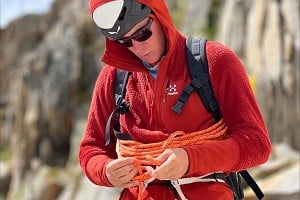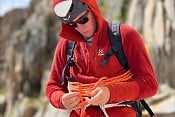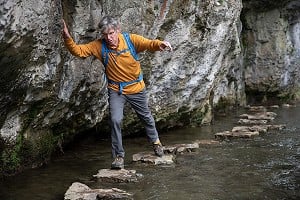
Note: Mountain photos were taken before the Coronavirus lockdown. At the moment we emphasise that no one should be travelling to the hills or crags.
Microfibre pollution has become a hot topic in recent years, and the bad news is that conventional synthetic fleeces contribute a lot. Whenever it is washed, a garment made of synthetic fibres will release some microfibres, tiny fragments thinner than human hair. Since neither washing machines nor sewage treatment works are typically built to filter them, they end up in the environment... and thus the food chain. In other words we are unwittingly ingesting our own clothes - and so are all sorts of other creatures. Polartec's Power Air fabric is a recent attempt to address this issue. We were impressed with the intention behind it when we reported on it at the ISPO trade show in January, but of course that's no substitute for trying it in the real world.
I've had a Power Air hoody made by a brand called Houdini (no, me neither) for a number of months now. My first impression - that it's more a lifestyle/fashion piece for casual walking than serious technical outdoor gear - has not been entirely dispelled after some proper use up snowy hills. However it has proved more practical and more adaptable than I initially assumed. But the top itself is a side issue; it's the fabric I'm interested in here.
Polartec have been wearing their environmental credentials on their sleeve for longer than most brands, and have, they tell us, accounted for recycling over 1 billion plastic bottles to date. For some time the company have been aware of the microplastic issue, they say, and have worked on finishing processes to produce fleece fabrics that shed fewer microfibres than other fleeces currently on the market. But even the best conventional fleece is going to shed fibres through normal wear and tear. In response, their Power Air fabric takes Polartec's efforts a big step further.
What is Power Air?
Taking bubble wrap as its inspiration, Power Air encapsulates the fluffy fleece fibres inside what they call a 'multilayer continuous yarn construction'. In simple terms this is like a series of tiny pockets, enclosing the air-trapping fleece insulation to reduce microfibre loss. The result, say Polartec, is a fabric that sheds up to five times less of that insidious pollutant than other premium fleece fabrics. I'm not sure what to make of that 'up to', but for anyone concerned about their environmental impact - and we all ought to be - any big reduction has to be considered good news. For me this is the primary selling point of Power Air.
"By using the efficiency of encapsulated air to shelter lofted fibres, Polartec Power Air will drastically improve how fabrics perform over their lifetime with respect to versatility, comfort, and sustainability," says Gary Smith, Polartec CEO.
"We're only beginning to realise the potential for this new type of fabric construction."
What's it like in use?
Like a conventional fleece, Power Air feels quick-drying, and I've worn it comfortably while walking hard across a range of temperatures and weather conditions, without feeling unduly sweaty. Despite the 'pocket' construction I've found it no more windproof than any normal fleece, and a cold mountain breeze cuts right through. I wouldn't consider that a disadvantage though, since letting wind in also means it lets hot sweaty air out. As with any fleece, you just need to remember to bring a windproof layer.
Without a fluffy inner face against your skin, Power Air doesn't feel as instantly snug as a normal fleece, and I'm not sure the tight little pockets could be expected to trap as much warm air as deeper, open fluffy stuff.
What's not to like?
From the perspective of someone who's wanting to wear this stuff up mountains, or while climbing, not to mention carrying it around in a pack, my practical concern is how warm it is for its weight - or, to put that another way, how heavy it for its warmth. The short answer is that the current version of Power Air weighs a ton, but offers only moderate insulating performance.
In size Large, my Houdini Power Air Houdi, in all other respects an entirely standard full zip fleece hoody, weighs a massive 720g. In contrast a random Polartec Power Stretch hoody from my cupboard weighs just 397g. I'd definitely say the Power Stretch feels warmer, and it's just over half the weight. For more serious technical uses, and I mean anything from hillwalking to alpinism, the first generation of Power Air is simply way too heavy. I guess the reason for this is all the extra fabric required to create that cell-like structure.
Luckily...
The Houdini Power Air Houdi is a nice top for general casual use and non-taxing country walks, but no matter how keen I am to see a reduction in microplastic pollution, I couldn't possibly endorse it beyond that level. But that's probably not the last word. The first generation of Power Air was released in 2018 - and perhaps it's telling that it has seen little uptake in serious outdoor gear as yet. In response, I assume, to the unavoidable weight issue, later this year Polartec will be releasing a new lightweight version of Power Air. Also made from one yarn, and with 73% recycled plastic content, this fabric will also be fully recyclable. If they can get the weight low enough to appeal to the more demanding outdoor user then Power Air could well be coming to a fleece near you. That would certainly be good news for the planet.
- For more info on Power Air see polartec.com



































Comments
<puts hand up/> I have sir! I have!
Houdini are Swedish - quite hipster-y with a dash of hippy. Or maybe quite hippy with a dash of hipster. Definitely not cheap but they've always been very keen on being as environmentally sustainable as possible and that's a big bit of their brand.
Mrs B has long, long arms which mean her jacket sleeves end to rise up her wrists. She was quite excited to find some Houdini Powerstretch wrist warmer sleeve things in a Naturkompaniet store in Stockholm about 15 years ago. Still going strong! As indeed are the sleeves.
Houdini popped up at SportPursuit recently so they must be making a push into the UK...
b
That weight is huge! You could get a large Nano-Air hoody for 376g, almost half the weight and you know it's going to be massively warmer.
Well, its great to see an outdoor material manufacturer taking the whole micro-plastic thing seriously.
In my normal wear I've largely switched to natural fibres because of this and infrequently wash my man-made fabric outdoor kit (aside from my baselayer which can be stinking - then again, my preferred baselayers are merino wool)
I'm surprised that Houdini was an unknown brand... outside Sweden Norway I've seen a lot of their stuff on Germans